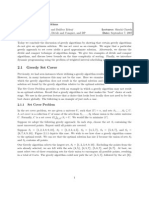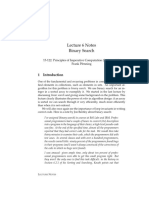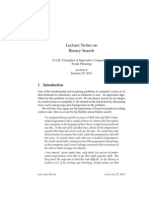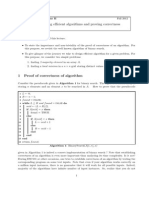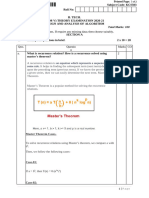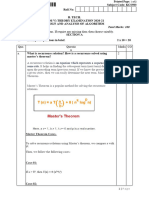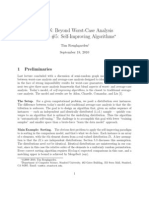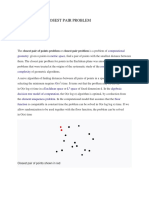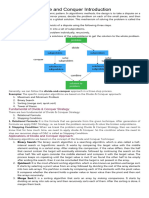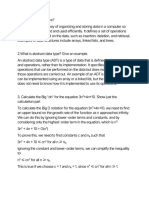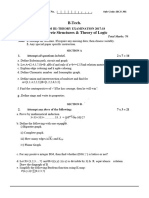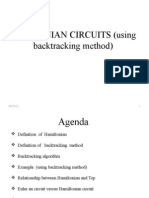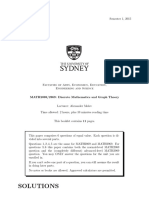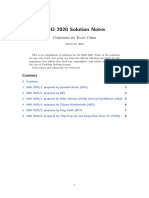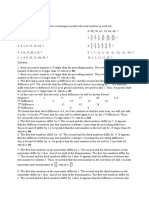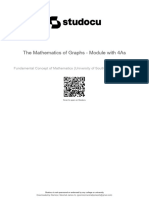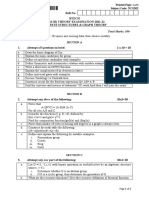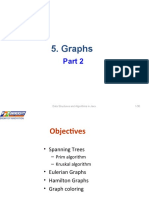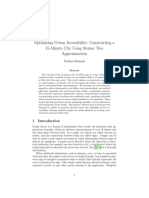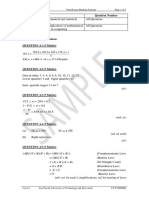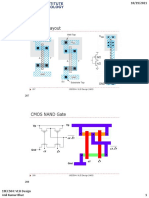CS1114: Study Guide 1: 1 Finding The Center of Things: Bounding Boxes, Cen-Troids, Trimmed Means, and Medians
CS1114: Study Guide 1: 1 Finding The Center of Things: Bounding Boxes, Cen-Troids, Trimmed Means, and Medians
Uploaded by
lightsaber5Copyright:
Available Formats
CS1114: Study Guide 1: 1 Finding The Center of Things: Bounding Boxes, Cen-Troids, Trimmed Means, and Medians
CS1114: Study Guide 1: 1 Finding The Center of Things: Bounding Boxes, Cen-Troids, Trimmed Means, and Medians
Uploaded by
lightsaber5Original Title
Copyright
Available Formats
Share this document
Did you find this document useful?
Is this content inappropriate?
Copyright:
Available Formats
CS1114: Study Guide 1: 1 Finding The Center of Things: Bounding Boxes, Cen-Troids, Trimmed Means, and Medians
CS1114: Study Guide 1: 1 Finding The Center of Things: Bounding Boxes, Cen-Troids, Trimmed Means, and Medians
Uploaded by
lightsaber5Copyright:
Available Formats
CS1114: Study Guide 1
In the rst part of this course, we have covered the topics in this document. Please refer to the class slides for more details.
Finding the center of things: Bounding boxes, centroids, trimmed means, and medians
(x1, y1), (x2 , y2), . . . , (xn , yn )
Given a collection of n 2D data points:
we discussed several ways to nd the center of the data: Bounding box. One simple way is to compute the bounding box of the data. The bounding box is the smallest axis-aligned rectangle that completely encloses the data, and is dened by a top row (top), a bottom row (bottom), a left column (left), and a right column (right). To nd the center of the data, we can nd the midpoint of the bounding box: bounding box midpoint = left + right top + bottom , . 2 2
This denition of center is very easy to compute. Unfortunately, it is very easy to skew with a single bad outlier. Centroid. A more robust measure of the center of the data is the centroid. The centroid is found by taking the average x-coordinate and the average y-coordinate: centroid = 1 n
n
i=1
1 xi , n
yi
i=1
The centroid is less sensitive to outliers than the bounding box midpoint. Unfortunately, one bad outlier can still skew the results (remember the example in class of the kindergarten class containing Arnold Schwarzenegger). Trimmed mean. This led us to the denition of the trimmed mean. The trimmed mean is computed by removing, say, the top 5% of the data and the bottom 5% of the data, then computing the mean of the result. This measure is robust to outliers (at least when less than 10% of the data are outliers). To compute the trimmed mean of 2D data, we would compute the trimmed mean of the x-coordinates, and the trimmed mean of the y-coordinates. 1
Median. Another robust measure of the center is the median. For a set of numbers x1, x2 , x3, . . . , xn , the median is the number smaller than half of the other numbers, and larger than half of the other numbers (if the list were sorted, it would be the middle element of the list). It is not clear how to dene the median for 2D data, but in class we have been using the median vector, whose x-ccordinate is the median of the x-coordinates, and whose y-coordinate is the median of the y-coordinates. Next, we will look at several algorithms for nding the medianor, in fact, the element of any rank in an array. Recall that we dened an element to be rank k if it is the kth-largest element in the array. Thus, the median in an array of n elements has rank n . 2
Algorithms and running time
An algorithm is a set of steps for solving a problem (such as nding the median of an array). There may be many dierent algorithms for solving a particular problemall correct algorithms will solve the problem, but dierent algorithms might vary in terms of ease of implementation, amount of memory used, and running time. In this class, we have been particularly interested in the last of these: running time.
2.1
Big-O notation.
To characterize the running time of a function, we have been using big-O notation, which expresses running time independent of what kind of hardware we run the algorithm on. Using this denition, the running time of an algorithm is, roughly speaking, proportional to the amount of work we have to do for an input of size n (as n gets very large).1 This leads us to several classes of algorithms: 1. O(1) (constant time). Algorithms which take a constant amount of time, no matter how big the input is (again, as n gets very large). Example: computing the third element in an array. 2. O(n) (linear). Algorithms which do work proportional to the size of the input. Example: computing the largest element in an array. 3. O(n log n) (loglinear, or quasi-linear). Algorithms which do work proportional to the size of the input times the log of the size of the input. Example: quicksort (expected run time). 4. O(n2 ) (quadratic). Algorithms which do work in proportion to the size of the input squared. Example: computing the median using repeated nd biggest. In class, weve looked at several algorithms for nding the median in an array:
1
Later CS courses cover the exact denition of big-O.
2.2
Repeated nd biggest
This algorithm nds the biggest element in the array, removes it, then nds the second biggest, removes it, and repeats, until it has removed the biggest n elements. The last 2 element removed is the median. Running time: O(n2 ). Explanation: every time we remove the biggest, we scan the entire array. The rst time, we scan n elements, the second time, n 1 elements, and so on, until the last time we scan n elements. The total amount of work is thus: 2 n + (n 1) + (n 2) + . . . + n 2
2
There are n terms in this sum, and each is n . Thus, we do at least n n = n amount of 2 2 2 2 4 workthis is proportional to n2 , so repeated nd biggest is O(n2 ). (Note that it is possible to compute the sum above exactlythe exact sum is still proportional to n2).
2.3
Quicksort
The next approach we covered was to sort the array rstit is then very simple to nd the median of a sorted array. So how do we sort an array? One approach is to use repeated nd biggest for the entire array, storing the biggest elements in another array in order as we nd them. However, this is not very helpful for nding the median, because it is doing strictly more work than the repeated nd biggest approach above. Thus, we looked at another sorting algorithm called quicksort. Quicksort has three steps: 1. Choose an element to be the pivot (this could just be the rst element, A(1), but a better choice is a random array element). 2. Partition the array into three subarrays A1, A1, and A3: one for elements smaller than the pivot (A1), elements equal to the pivot (A2), and elements larger than the pivot (A3). 3. Recurse: quicksort arrays A1 and A3 separately, then join them together (sandwiching A2). Running time: O(n log n) (expected), O(n2 ) (worst case). Explanation: The worst case running time of quicksort is O(n2 ): if we choose the rst element as the pivot each time, and the array is already sorted, then we break the array into one empty partition (A1) and one large partition with only one element removed (A3) each time we partition, resulting in having to partition n 1 times (scanning all of the remaining elements in the large partition each time). However, if we get lucky and partition the array in half each time, we divide the array in half log2 (n) times, and each time we scan approximately n elements in total. This leads to a running time of O(n log n) in the best case.2 For random inputs, we get lucky enough, and quicksort has an expected running time of O(n log n).
A fact about logarithms is that we can convert between bases using the formula loga n = logb n/ logb a thus, all logarithmic functions loga are proportional to each other, so it doesnt matter what base logarithm we use inside the big-O.
2
2.4
Quickselect
However, for nding the median, it turns out that we can do better. The intuition is that we dont care about sorting the entire arraywe just care about what the median element is. Thus, we can skip some of the work in quicksort; the resulting algorithm is called quickselect. Quickselect can be used to nd any element of rank k, and is very similar to quicksortin fact, the rst two steps are identical to quicksort: 1. Choose an element to be the pivot (this could just be the rst element, A(1)). 2. Partition the array into three subarrays: one for elements smaller than the pivot (A1), elements equal to the pivot (A2), and elements larger than the pivot (A3). 3. If k <= length(A3), then recursively nd the k th largest element in A3 4. If k > length(A2) + length(A3), then let j = k - (length(A2) + length(A3)), and recursively nd the j th largest element in A1 5. Otherwise, return x. Unlike quicksort, quickselect throws away one of the partitions A1 or A3 each time, because it knows which partition the kth-largest element must belong to (quicksort, in comparison, recurses on both partitions). Running time: O(n) (expected), O(n2 ) (worst case). Explanation: The same worst case of quicksort applies to quickselect. On the other hand, we can get lucky in several ways. The rst is if length(A3) is exactly k 1we then know that the pivot is the kth-largest element, and can immediately return it. The other way we could get lucky is by partitioning the array into two equal-sized parts each time (as with quicksort). Again, if we get so lucky, we will split in half log2 n times, but each time we split we will do half as much work as the previous time, because we throw away half of the array. Thus, the amount of work we do is approximately: n n n n+ + + + ... + 1 2 4 8 This sum is approximately 2n. Thus, we do work in proportion to n, so in this case quickselect is O(n). Again, for random inputs we get lucky enough, and quickselect has an expected running time of O(n).
Graphs
The above algorithms gave us a fast way of nding the median. However, we can do better in detecting the lightstick by rst nding the largest blob of pixels (this is presumably the lightstick), and nding the median of only that blob. Dening what a blob is led us to the concept of a graph.
Figure 1: A graph with six nodes and seven edges.
3.1
Denition
A graph consists of a set of objects (called vertices) and links between the objects (called edges). More formally, a graph G consists of a vertex set V = {v1 , v2, . . . , vn } and an edge set E, where E contains pairs of vertices (vi , vj ). An example of a graph is shown in Figure 1. Graphs can represent many dierent things, including airports and direct connections, people and friendship relationships, Internet hosts and wired connections, and so on.
3.2
Paths and cycles
When dealing with graphs, we often want to talk about sequences of vertices linked by edges. A path is just such a sequence, i.e., a sequence of vertices vi1 , vi2 , . . . , vik , where each consecutive pair of vertices is linked by an edge. For instance, 1, 5, 4, 6 is a path in the graph in Figure 1. A path that starts and ends at the same vertex is called a cycle. An example of a cycle in the graph above is 2, 3, 4, 5, 2.
3.3
Types of graphs
There are many special types of graphs that are useful to know about. These include: Connected graphs. Two vertices are connected in a graph if there is a path between them. A graph itself is said to be connected if all pairs of vertices are connected (for instance, the graph in Figure 1 is connected). Trees. A tree is a connected graph with no cycles. An example of a tree is shown in Figure 2. Planar graphs. A planar graph is a graph that can be drawn with no edge crossings (remember that when drawing a graph, it is acceptable to move vertices around, and to draw curved edges, as long as the connectivity doesnt change). The graphs in Figures 1 and 2 are both planar. However, the graph in Figure 3 is not planar (though this is dicult to prove).
Figure 2: An example of a tree.
Figure 3: An example of a non-planar graph.
3.4
Graph problems
Many problems in the real-world can be posed as graph problems. Here, we review some common graph problems.
Figure 4: A graph with a Hamiltonian cycle (shown in red).
Hamiltonian cycle A graph has a Hamiltonian cycle if it contains a cycle that visits each vertex exactly once (except for the rst vertex, which will also be the last vertex in the cycle; i.e., this vertex is visited twice). An example is shown in Figure 4.
Eulerian cycle A graph has a Eulerian cycle if it contains a cycle that visits each edge exactly once (but can visit each vertex as many times as needed).
Figure 5: A valid coloring of a graph. Graph coloring A graph coloring is the assignment of colors to each vertex such that no two vertices connected by edges are the same color. For instance, the graph in Figure 5 is shown with a valid coloring using three colors. Colorings are useful for solving problems where we need a assign one of a list of possible labels to each vertex, but where there are conicts preventing certain pairs of vertices from having the same label (these conicts can be represented by edges. An example was given in class of using graph colorings to solve the problem of assigning frequencies to radio stations, where two radio stations were connected if they had an overlapping broadcast region (and thus had to be assigned dierent frequencies to avoid interference). (See the slides for Lecture 7 for more details on this problem.) A useful fact is that planar graphs can always be colored with four colors. Other graphs may require many more than four colors for a valid coloring.
Connected components
Even if a graph is not connected, it will consist of parts that are connected. Each part is called a connected component. To nd a connected component, we need a way to traverse a graph from some starting point, marking down all of the vertices we visit. This leads to the problem of graph traversal.
4.1
Graph traversal
The basic strategy in graph traversal is to start with a vertex, visit its neighbors, then visit its neighbors neighbors, and so on, until we are done. To make this into an algorithm, we need a way to keep track of vertices which we still need to visit (a todo list). Two ways of implementing such a todo list are stacks and queues.
4.2
Stacks (DFS) and queues (BFS)
A stack is a way of storing a todo list where, when we need to take something from the list, we always take the last thing that was added (as with a stack of cafeteria trays). Thus, a stack is a LIFO (last in, rst out) data structure. A queue is a todo list where we always take the rst thing added o the list (as with a queue of people in line for a movie). A queue is thus a FIFO (rst in, rst out) data structure. When we implement graph traversal using a stack, the resulting algorithm is called depthrst search (DFS). When we use a queue, the resulting algorithm is called breadth-rst search (BFS). Please see the slides for more details on these algorithms.
Figure 6: Conceptual diagram of a singly-linked list with elements 42, 18, and 10.
Figure 7: Possible layout of a singly-linked list in memory.
Linked lists
In order to implement a todo list, a useful data structure is a linked list. A linked list is an alternative to an array, and consists of cells, where each cell contains a value (as with an array), and a pointer to the next cell (the last cell contains a pointer to 0, called the null pointer). In addition to cells, a linked list contains a header with two pieces of information: the location of the rst cell, and the size of the list. An example of a (conceptual) linked list is shown in Figure 6, and a possible representation in memory is shown in Figure 7.
Figure 8: Conceptual diagram of a doubly-linked list with elements 42, 18, and 10. Linked lists allow for ecient insertion and deletion from the start of a list, unlike with an array, where we need to shift elements around to insert or delete from the front. Unfortunately, to eciently implement queues, we also need to be able to quickly insert or delete from the end of a linked list. To enable ecient operations at the end, we described in class a more complex doubly-linked list (as opposed to the singly-linked lists described above). Each cell in a doubly-linked list also has a pointer to the previous element, and the header of the 8
Figure 9: Possible layout of a doubly-linked list in memory.
list contains a pointer to the last element. An example of a doubly-linked list is shown in Figure 8, and a possible layout in memory is shown in Figure 9. Doubly-linked lists allow for ecient (O(1)) insertion and deletion from the start and end of a list, unlike arrays, where these operations are O(n) in general (where n is the length of the array). On the other hand, nding a given element of a linked list may take longer than with an array. To access the middle element of a linked list, we must traverse the list from the beginning (or end), until we reach the middle.
You might also like
- Introduction To Decision Maths PDFDocument30 pagesIntroduction To Decision Maths PDFAnonymous 5Qtn0QVDuONo ratings yet
- Lecture 02Document10 pagesLecture 02prachiNo ratings yet
- Introduction & Median Finding: 1.1 The CourseDocument8 pagesIntroduction & Median Finding: 1.1 The CourseRameeshPaulNo ratings yet
- 20MCA023 Algorithm AssighnmentDocument13 pages20MCA023 Algorithm AssighnmentPratik KakaniNo ratings yet
- Mergesort / Quicksort: Steven SkienaDocument32 pagesMergesort / Quicksort: Steven SkienaCraig MNo ratings yet
- Cs 161 Lecture 04Document6 pagesCs 161 Lecture 04divyatamboli08No ratings yet
- SortingDocument10 pagesSortingdobrev666No ratings yet
- 06 BinsearchDocument15 pages06 BinsearchaisahmNo ratings yet
- 1 Overview: Lecture 2 - February 3, 2005Document6 pages1 Overview: Lecture 2 - February 3, 2005ozturk_nihalNo ratings yet
- 8.5 Selecting The MTH Largest: Indx (1..n) Indexx Irank (1..n)Document5 pages8.5 Selecting The MTH Largest: Indx (1..n) Indexx Irank (1..n)Vinay GuptaNo ratings yet
- Blaeser Algorithms and Data StructuresDocument109 pagesBlaeser Algorithms and Data StructuresMaia OsadzeNo ratings yet
- Re Sizable ArraysDocument12 pagesRe Sizable ArraysSeraphina NixNo ratings yet
- Merge Sort: Divide and ConquerDocument18 pagesMerge Sort: Divide and ConquervinithNo ratings yet
- Binary SearchDocument5 pagesBinary SearchUniversal CollegeNo ratings yet
- DSA Assignment 1-SolutionsDocument10 pagesDSA Assignment 1-SolutionsChatianya ChaniyaraNo ratings yet
- 05 SortDocument12 pages05 Sortderrickarenas14No ratings yet
- Binary Tree MiscellaneousDocument3 pagesBinary Tree MiscellaneousAasthaNo ratings yet
- DAANotesDocument12 pagesDAANotesManika GoyalNo ratings yet
- Lecture 5Document15 pagesLecture 5AbdurroufNo ratings yet
- I I N (N + 1) I N 1 N I .: 1.13 Amortized AnalysisDocument4 pagesI I N (N + 1) I N 1 N I .: 1.13 Amortized AnalysisKaran DesaiNo ratings yet
- Unit-1 DaaDocument4 pagesUnit-1 DaaMOHAMMAD ALI YASINNo ratings yet
- Binary SearchDocument12 pagesBinary SearchpetejuanNo ratings yet
- DAA Practical FileDocument41 pagesDAA Practical Filepavitra.bijytNo ratings yet
- Vet. AssignmentDocument16 pagesVet. AssignmentAbdulsamadNo ratings yet
- Lecture 4 CS210 2012 PDFDocument4 pagesLecture 4 CS210 2012 PDFMoazzam HussainNo ratings yet
- Assignment 1 AoADocument14 pagesAssignment 1 AoAyounuskhansherani045No ratings yet
- 0.1 Worst and Best Case AnalysisDocument6 pages0.1 Worst and Best Case Analysisshashank dwivediNo ratings yet
- MidsemDocument6 pagesMidsemAravind SomasundaramNo ratings yet
- Algorithms Part 1 - Lecture Notes: 1 Union FindDocument6 pagesAlgorithms Part 1 - Lecture Notes: 1 Union FindJackNo ratings yet
- Design and Analysis of AlgorithmDocument33 pagesDesign and Analysis of AlgorithmajNo ratings yet
- Analysis of Merge SortDocument6 pagesAnalysis of Merge Sortelectrical_hackNo ratings yet
- DAA-20-21Document27 pagesDAA-20-21utkarsh7553No ratings yet
- DAA-20-21Document28 pagesDAA-20-21rajesh.kumarcisceNo ratings yet
- CS369N: Beyond Worst-Case Analysis Lecture #5: Self-Improving AlgorithmsDocument11 pagesCS369N: Beyond Worst-Case Analysis Lecture #5: Self-Improving AlgorithmsJenny JackNo ratings yet
- Ae Chapter2 MathDocument44 pagesAe Chapter2 MathjruanNo ratings yet
- 0.1 Review (Recurrences)Document8 pages0.1 Review (Recurrences)shashank dwivediNo ratings yet
- Algorithmic Designing: Unit 1-1. Time and Space ComplexityDocument5 pagesAlgorithmic Designing: Unit 1-1. Time and Space ComplexityPratik KakaniNo ratings yet
- Data Structure Unit 3 Important QuestionsDocument32 pagesData Structure Unit 3 Important QuestionsYashaswi Srivastava100% (1)
- Different Complexities With Suitable ExamplesDocument27 pagesDifferent Complexities With Suitable ExamplesChirag DesaiNo ratings yet
- Lec 8Document2 pagesLec 8jeeadvitb.ac.inNo ratings yet
- Design and Analysis of Algorithms - Tutorial Sheet PracticeDocument2 pagesDesign and Analysis of Algorithms - Tutorial Sheet PracticeMIHIKA PARAG DESHPANDENo ratings yet
- 06 BinsearchDocument15 pages06 BinsearchRajdip PalNo ratings yet
- hw3 14Document7 pageshw3 14Jiyang XieNo ratings yet
- Closest Points ProblemDocument11 pagesClosest Points ProblemSom SirurmathNo ratings yet
- CSF211 2024 MidsemSolutionsDocument6 pagesCSF211 2024 MidsemSolutionsDIY HJ HACKSNo ratings yet
- Algorithms for Massive Data ProblemsDocument28 pagesAlgorithms for Massive Data ProblemsrucywlNo ratings yet
- DAA Module-1Document21 pagesDAA Module-1Krittika HegdeNo ratings yet
- Lower Bound TheoryDocument14 pagesLower Bound Theoryyiyenor596No ratings yet
- Algorithm 1Document6 pagesAlgorithm 1Pinaki RanjanNo ratings yet
- Basic PRAM Algorithm Design TechniquesDocument13 pagesBasic PRAM Algorithm Design TechniquessandeeproseNo ratings yet
- Data Structure Module 1Document10 pagesData Structure Module 1ssreeram1312.tempNo ratings yet
- 161 MainDocument51 pages161 Mainmyturtle game01No ratings yet
- S MidsolDocument3 pagesS MidsolSachin MichuNo ratings yet
- UntitledDocument11 pagesUntitledAyaan LandgeNo ratings yet
- Probabilistic Analysis and Randomized Quicksort: T T (I) T T (I)Document7 pagesProbabilistic Analysis and Randomized Quicksort: T T (I) T T (I)Sangeeta JainNo ratings yet
- Quick Sort Lomu ToDocument4 pagesQuick Sort Lomu ToJesus Moran PerezNo ratings yet
- MaxsubseqsumDocument5 pagesMaxsubseqsumKotesh ChunduNo ratings yet
- 1.2 ArrayDocument53 pages1.2 ArrayVivek PandeyNo ratings yet
- Ada Answers Simp M1,2,3Document33 pagesAda Answers Simp M1,2,3Akash PaulNo ratings yet
- Discrete Structure 2017-18-1Document2 pagesDiscrete Structure 2017-18-1Sachin GuptaNo ratings yet
- (Student's Handouts) Mathematics of Graphs PDFDocument13 pages(Student's Handouts) Mathematics of Graphs PDFAlexandra Rose IslesNo ratings yet
- Mfcs 2007Document10 pagesMfcs 2007andhracollegesNo ratings yet
- HAMITONIAN CIRCUITS (Using Backtracking Method)Document15 pagesHAMITONIAN CIRCUITS (Using Backtracking Method)manas_kumar_2370% (10)
- MATH1081 Discrete Mathematics Tutorial Problems and Past Exam Papers With SolutionsDocument73 pagesMATH1081 Discrete Mathematics Tutorial Problems and Past Exam Papers With SolutionsShirley XuNo ratings yet
- Question BankDocument22 pagesQuestion Bankshalika booma75% (4)
- Traversable GraphDocument12 pagesTraversable Graphvishalkedia28No ratings yet
- 2015 ExamsolsDocument11 pages2015 ExamsolsMrWaratahsNo ratings yet
- DM End Sem Solve QP 1Document18 pagesDM End Sem Solve QP 123om.chaudhariNo ratings yet
- Graph Thoery ExcrciseDocument23 pagesGraph Thoery Excrciseummay rubabNo ratings yet
- Daa CombinedDocument407 pagesDaa CombinedmghNo ratings yet
- Microprocessor Exit Exam Reviewer: B. CMC - Complement Carry C. CLD - Clear Direction FlagDocument20 pagesMicroprocessor Exit Exam Reviewer: B. CMC - Complement Carry C. CLD - Clear Direction Flagpclr07No ratings yet
- IMO 2020 Solution Notes: Compiled by Evan ChenDocument9 pagesIMO 2020 Solution Notes: Compiled by Evan ChenSidiabdalla MouemelNo ratings yet
- Instructor Guide: Activity 1: Real River Problem SheetsDocument4 pagesInstructor Guide: Activity 1: Real River Problem SheetsshantanukanadeNo ratings yet
- Execise Sets (Week 1-7) Darren Daniel InfanteDocument18 pagesExecise Sets (Week 1-7) Darren Daniel InfanteDarren Daniel InfanteNo ratings yet
- The Mathematics of Graphs Module With 4asDocument39 pagesThe Mathematics of Graphs Module With 4asMarshall james G. RamirezNo ratings yet
- Btech Cs 3 Sem Discrete Structure and Graph Theory ncs302 2022Document2 pagesBtech Cs 3 Sem Discrete Structure and Graph Theory ncs302 2022Vishal Kumar SharmaNo ratings yet
- W7 AssignmentDocument3 pagesW7 AssignmentMorassa ChonaNo ratings yet
- Travelling Salesman and Distribution Problems: Ik Ij JKDocument11 pagesTravelling Salesman and Distribution Problems: Ik Ij JKRamrajNo ratings yet
- PDF Solutionsmanualforgraphtheorypdf DDDocument15 pagesPDF Solutionsmanualforgraphtheorypdf DDhp_blacklight74020% (1)
- Graphs: Data Structures and Algorithms in Java 1/30Document30 pagesGraphs: Data Structures and Algorithms in Java 1/30Bảo Quốc100% (1)
- Cse 5Document14 pagesCse 5loveshgoel1994No ratings yet
- CSE 548 Homework Assignment 5 Solutions/HintsDocument3 pagesCSE 548 Homework Assignment 5 Solutions/HintsTheAkHolicNo ratings yet
- Optimizing Urban Accessibility Constructing ADocument13 pagesOptimizing Urban Accessibility Constructing AgesuNo ratings yet
- Jesusa Mary Jane L. - BEED 1B - LM 6Document5 pagesJesusa Mary Jane L. - BEED 1B - LM 6mary jane jesusaNo ratings yet
- Sample Exam (MS)Document5 pagesSample Exam (MS)dropjarNo ratings yet
- Cs6702 QB CseDocument47 pagesCs6702 QB CseSatheesh Kumar MNo ratings yet
- Part 2 Chapter 1 - Graph FundamentalsDocument138 pagesPart 2 Chapter 1 - Graph FundamentalsLại Quang HuyNo ratings yet
- Inverter Layout: 19EC504: VLSI Design (AKB) 287Document8 pagesInverter Layout: 19EC504: VLSI Design (AKB) 287Keerthan .R.VarmaNo ratings yet

